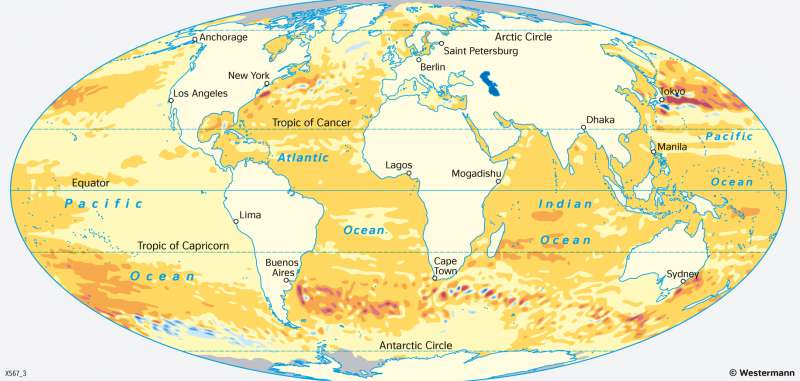World Oceans - Sea level change
Atmosphere and climate change
978-3-14-100890-6 | Page 20 | Ill. 4

Overview
In the course of the global climate debate since the end of the 20th century, the focus has repeatedly been on one particularly striking consequence of global warming: sea level change. As the first consequences of this trend can already be observed and large parts of the world's population live in coastal areas, this topic continues to gain global importance.
Measurable extent of sea level change
The map shows the average annual change in sea level in the period 1993-2010. The diagram enables a classification over a longer period. It shows that sea levels have risen by more than 20 centimetres since 1880 on a global average, but regionally much higher rises have also been observed. Sea level rise has two main causes. Firstly, the current increase in air temperatures is leading to a warming of the sea water near the surface in particular. The water expands and the sea level rises (thermal expansion). On the other hand, glacier ice and ice sheets are melting as a result of the increasing air temperatures (ice melt). This leads to an increased input of water into the oceans. This increases the amount of water in the oceans and consequently the sea level. (Other influencing factors include land uplift and subsidence.) The current contributions of the two main causes can be estimated using the period 2003-2008. The average sea level rise during this period was 2.5 millimetres per year. Of this rise, thermal expansion accounted for one quarter and ice melt for three quarters (two quarters from polar ice caps/shields plus one quarter from inland glaciers outside the polar regions).
Prehistoric fluctuations of sea level
Large fluctuations in sea level over geological periods have been documented many times. For example, during the Weichselian glaciation period, sea level was about 120 metres lower than it is today. However, the Earth is inhabited by more than seven billion people today; coastal areas are among the preferred, particularly densely populated areas. This makes changes in sea level so explosive. According to current forecasts, sea level rise will continue in the 21st century as a result of climate change. Model calculations show increases of up to one metre by the year 2100. Such forecasts show how dramatic the development will be for coastal lowlands and shallow islands.
Variety of sea level change factors
The interplay of a wide variety of factors - for example, the globally varying increase in air temperature, the density anomaly of water, changes in the salinity of seawater and the dynamics of ocean currents - means that the rise in sea level is not uniform worldwide. In addition to areas with above-average rises (Western Pacific), there are also areas where the average sea level is falling (Eastern Pacific). Often these areas are even in close proximity to each other, for example in the southern Indian Ocean and the Northwest Atlantic.
Acutely endangered areas
The most endangered areas include, for example, the Netherlands, Florida, and Bangladesh, as well as island groups in the Indian and Pacific Oceans. There, not only will normal water levels rise, but also the risk of damage from flooding during storms. The extent of the damage will largely depend on the extent to which the respective states and societies are able to take precautions through adaptation strategies and build up coping capacities. This will be much more difficult for economically weak countries with a low level of development (such as Bangladesh and many of the small island states) than for economically strong countries with a high level of development (such as the Netherlands and the USA).




